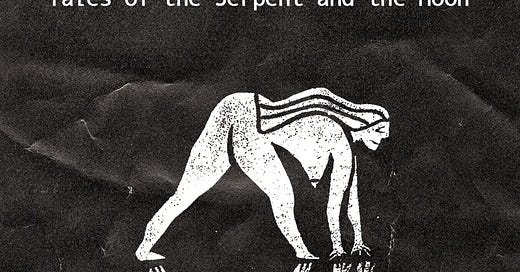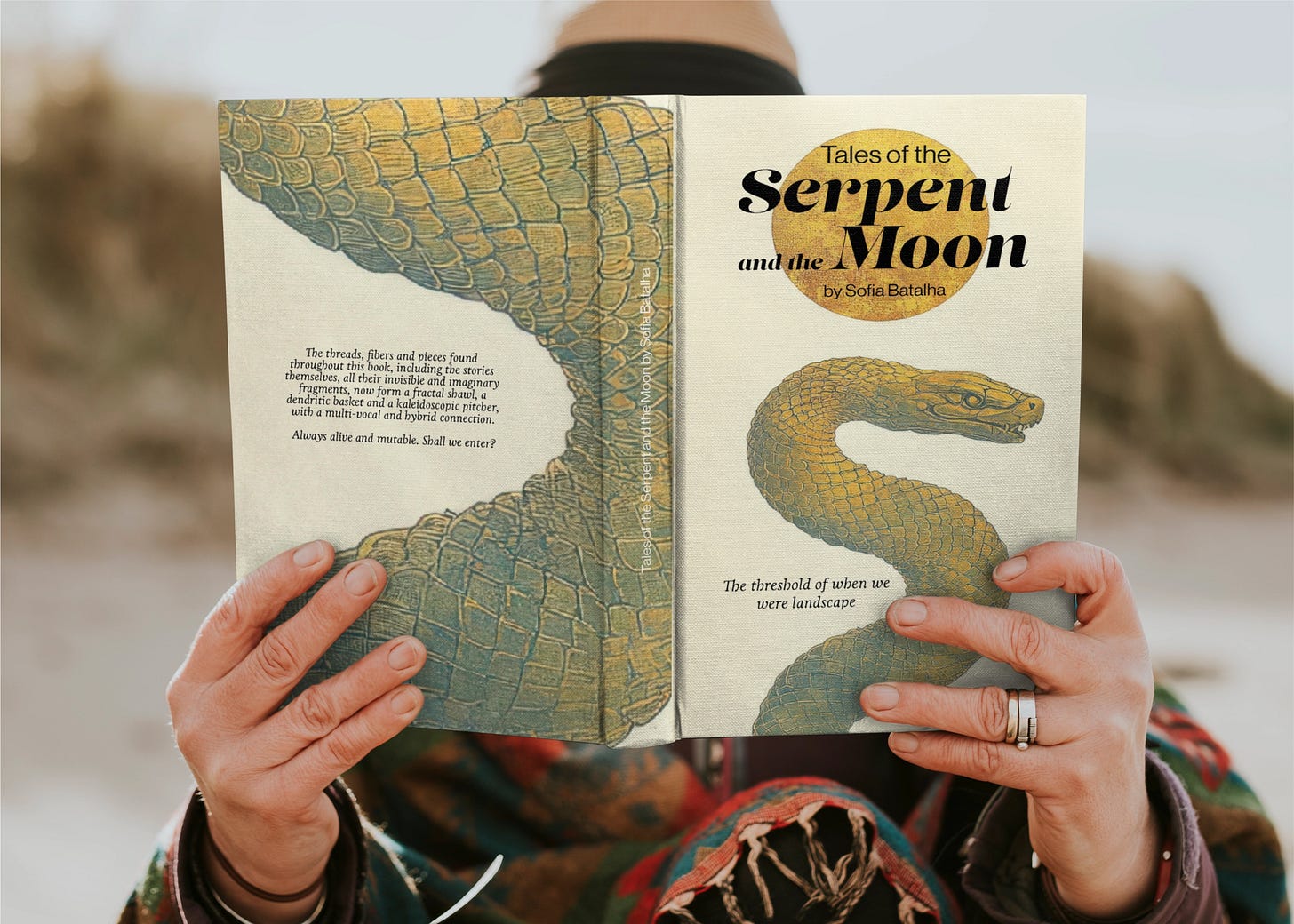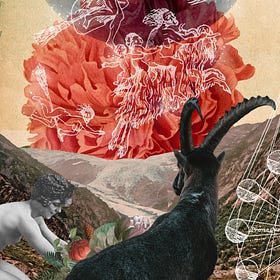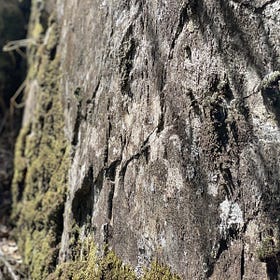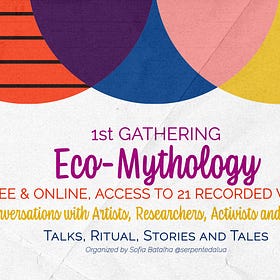Dear reader,
Please note that the content shared here on Substack will differ from what appears in the printed book. While many of the themes, stories, and inquiries may echo across both formats, the book itself has undergone a thorough process of review, editing, refinement, and expansion. In that sense, the printed version holds a more curated, deepened, and embodied iteration of the work.
Think of the Substack as a living ground, where ideas are still fermenting, evolving, and growing their tendrils. The book, meanwhile, is a vessel, harvested with care, ripened in its season, and offered as a more coherent ceremonial bundle.
With tenderness for the ongoingness of becoming,
—Sofia
Tales of the Serpent and the Moon
Seven living tales from deep landscapes and bone memory.
Stories of ancient places of the primal and wild female Soul.
Nurturing these stories1 and their contexts was not an academic process or a laboratory investigation, linear or classical. This rescue is a sensory somatic journey of fractal, kaleidoscopic and dendritic connection, both cosmic and telluric, opening space between dogmas and cultural expectations, touching textures, and emotions. These are tales rescued through and by the body in spontaneous, organic, and live movement, discovering forgotten, exiled, mutilated, or even neglected landscapes.
In these mythical fabulations, the archaic geography of death is naturally included as an inherent part of life, just as the transitional landscapes, uncertainty and vulnerability, and the unknown territories, both invisible and even dangerous, as our ancestors knew so well.
These stories are an expression of many places. Seven tales of landscapes where women have not been drastically forced to forget their sovereignty have not been raped, kidnapped, or taken by force. Here we walk deliberately through a mythical landscape, feminine and chthonic, in visceral intimacy with the sacred depths of the earth, on an immanent pilgrimage.
Ancient Tales for Modern Times
For twenty years, I’ve been working with people and places, and I also write fabulated tales from pre-agrarian realities, echoing whispers from the land, recollecting shamanic ancient ways of life in the Iberian Peninsula. These contextual stories are not escapes from the perilous times we live in.
The Tales of the Serpent and the Moon follow the deep principles of shamanic, animistic, fractal, systemic, and complex experience, being imagined and creative fabulations of tales from place and bone, according to ancestral perspectives.
Some of these stories came to me through dreams that I ventured into telling and writing. Others were imagined recreations of various mythical elements, from tales of the places of this territory and their native symbolism to fabulations of other tales like Little Red Riding Hood or Cinderella.
These living tales were offered to me; I offered them to my daughters and now to those who read them.
These tales are dedicated to the Ancestors, Healers, Herbalists, Weavers, Sorcerers, Benzedeiras, Curandeiras, Singers, Midwives, Poetesses, Weavers and Sowers, but also to the Fairies, Witches, Moors, and their primal wisdom alive, somatic, shamanic, haptic, herbalist, magical and cyclic.
Radical principles of animist and shamanic practice in southwestern European territory
The rescue and remembrance of the ancient and complex systemic wisdom of the place we occupy is a life process that must be cared for and attended to with responsibility, integrity, and humbleness. I leave you some of the stones that guide my path. 1. Sacredness of nature
We begin with seven stories, living tales from the memory of bones, narratives from deep landscapes.
They are tales for adults and possibly for children, echoes coming from an ancient place of the primal, mysterious, wild female memory.
There are many ways to read, taste, listen, tell, or sing them. We can read just one story and enter into its rhythm, allowing it to act in us, ruminating about what it opens or closes to us, breathing its landscape, and consenting for it to fertilize our dreams. Here we have a license to linger, slowly feel, and listen with each pulse and breath.
We are not rushing and don't have to know everything or even understand. We can read "what breathes the tale," what threads wove it, what shards were glued together, or the native symbolism that generated each story and its characters.
But we don't have to. We risk surrendering to reading the final articles for common ground to all the tales that live through these pages: what perceptions, thoughts, and perspectives serve as their roots, allowing us to dive into the cosmic-chthonic cartography of the wild Iberian mythology.
But we don't have to.
We can simply savor a tale.
Why are these tales important now?
INTRO, tale list and chapter references.
THE TALES
The Goat Girl - Belinda & Benilde & What breathes through the Tale
The Shepherdess - Hystera and the thread of life & What breathes through the Tale
The Red Cloak - Ananta the She-Wolf Woman & What breathes through the Tale
Lucífera and the Cauldron - The Cinder Girl & What breathes through the Tale
Carisa - The First Wailer & What breathes through the Tale
Monster Sanctuary - Brufe and the Bears & What breathes through the Tale
Queen of the West Sea - Oki-usa and the Black Rock & What breathes through the Tale
FOLLOWING CHAPTERS
Remembering the Tales / Disappointed Moors - The Disenchantment of Growing up Storyless, Part I
Disappointed Moors - The Disenchantment of Growing up Storyless, part II
Washing Moors - Washing History, part I
Washing Moors - Washing History, part II
Builder Mouras - Mythical Territory
Warrior Mouras - Guarding and Protecting the Sacred - Part I
Warrior Mouras - Guarding and Protecting the Sacred - Part 2
Enchanted Mouras - The Power of Imagination
Spinning Mouras - Telling and Weaving the Stories
From the Book - Contos da Serpente e da Lua, Sofia Batalha(in portuguese)
Other Articles of Interest
Welcome to the first Eco-Mythology Gathering in Portugal
This is a pioneering gathering in Portugal about the need to intertwine Ecology and Mythology; about the importance of how we tell stories, be they personal, cultural, social, scientific, or even political. ACCESS the Event here. Twenty-one 45 min recorded presentations, in English and Portuguese (English subtitles available), for you to watch at your ow…
The Earth Body
Article I wrote for @STCWpublishing This article is possibly an event, activity, practice, even a ritual. Or maybe it is just a story, even though an ancient one. The mythology presented in the bones of this melody of words is based upon wild, pre-roman, telluric (sacred energy emanating from the earth itself)
The Sanctuary
My current line of work keeps me looking for stories of place, and myths, constantly searching for different versions of local folktales. One of my motivations to keep unearthing and recovering the submerged layers of my culture, is to rescue other ways of relating, different forms …
References
A. Harris-Logan, Stuart. Singing with Blackbirds: The Survival of Primal Celtic Shamanism in Later Folk-Traditions. Grey House in the Woods, 2006.
A.P. Ruck, Carl, et al. The Hidden World: Survival of Pagan Shamanic Themes in European Fairytales. Carolina Academic Press, 2007.
Asma, Stephen T., and Brigid Hains. “Imagination is such an ancient ability it might precede language.” Aeon, 11 September 2017, https://aeon.co/essays/imagination-is-such-an-ancient-ability-it-might-precede-language.
Batalha, Sofia. Pequeno Livro da Imanência. Edição de Autor, 2020.
Batalha, Sofia. Um Lugar Feliz. IN - Zero a Oito, 2020.
Blackie, Sharon. If Women Rose Rooted: A Life-changing Journey to Authenticity and Belonging. September Publishing, 2019.
“Breve história da Inquisição em Portugal.” RTP Ensina, https://ensina.rtp.pt/artigo/breve-historia-da-inquisicao-em-portugal/.
Crouch, Doug. “Dendritic.” Permaculture Design Course Handbook, https://treeyopermacultureedu.com/chapter-4-pattern-understanding/dendritic/.
Dashu, Max. “Excerpt from the SECRET HISTORY OF THE WITCHES .... Max Dashu.” Suppressed Histories, 2000, https://www.suppressedhistories.net/secrethistory/oldgoddess.html.
Frazão, Fernanda, and Gabriela Morais. Portugal, Mundo dos Mortos e das Mouras Encantadas. Apenas Livros, 2019.
The Guardian. “Forgotten fairytales slay the Cinderella stereotype.” The Guardian, https://www.theguardian.com/books/2014/dec/26/fairytale-ending-forgotten-folklorist-schonwerth.
Lecouteaux, Claude. Demons and Spirits of the Land: Ancestral Lore and Practices. Inner Traditions, 2015.
Lecouteaux, Claude. Witches, Werewolves, and Fairies: Shapeshifters and Astral Doubles in the Middle Ages. Inner Traditions, 2003.
Lopes, Aurélio. Tempo de solstícios. O Mirante, 1998.
Machado de Oliveira, Vanessa. Hospicing Modernity. North Atlantic Books, 2021.
Marks-Tarlow, Terry. Psyche's Veil Psychotherapy, fractals and complexity. Taylor & Francis, 2008.
McKenna, Terence. O pão dos deuses: em busca da árvore do conhecimento original: uma história radical das plantas, das drogas e da evolução humana. Via Óptima.
“MOIRAE (Moirai) - The Fates, Greek Goddesses of Fate & Destiny (Roman Parcae).” Theoi Greek Mythology, https://www.theoi.com/Daimon/Moirai.html. Accessed 13 November 2021.
Narby, Jeremy. The Cosmic Serpent: DNA and the Origins of Knowledge. Orion Publishing Group, Limited, 1998.
Parafita, Alexandre. A Mitologia dos Mouros. Gailivro, 2006.
Science News. “No fairy tale: Origins of some famous stories go back thousands of years.” Science News, https://www.sciencenews.org/article/no-fairy-tale-origins-some-famous-stories-go-back-thousands-years.
Sellers, Charles. “Contos das Terras das Nozes e das Uvas.” World of Tales, https://www.worldoftales.com/Spanish_Portuguese_folktales.html.
Shaw, Martin. Courting the Wild Twin. Chelsea Green Publishing, 2020.
Tomanek, Jeanie, and Terri Windling. “Myth & Moor: Wild Sanctuary and The Handless Maiden.” Terri Windling, 1 February 2018, https://www.terriwindling.com/blog/2018/02/handless-maiden.html.
W. Kremer, Jürgen, and River Jackson-Paton. Ethnoautobiography. Kendall Hunt Publishing, 2018.
These tales were originally written in Portuguese, in my book “Contos da Serpente e da Lua”, ISBN: 978-989-9005-84-6. All illustrations are from Carolina Mandrágora. Edited in Portugal by Mahatma Editora.

